Expressive Resources of the Language 2 Points

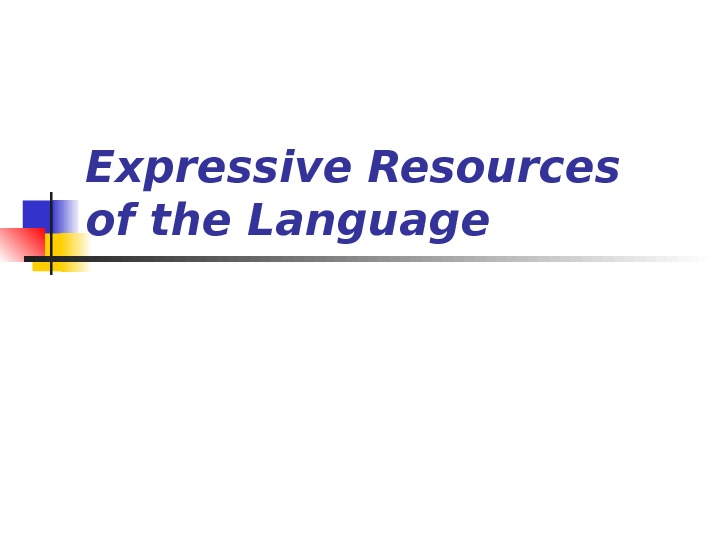
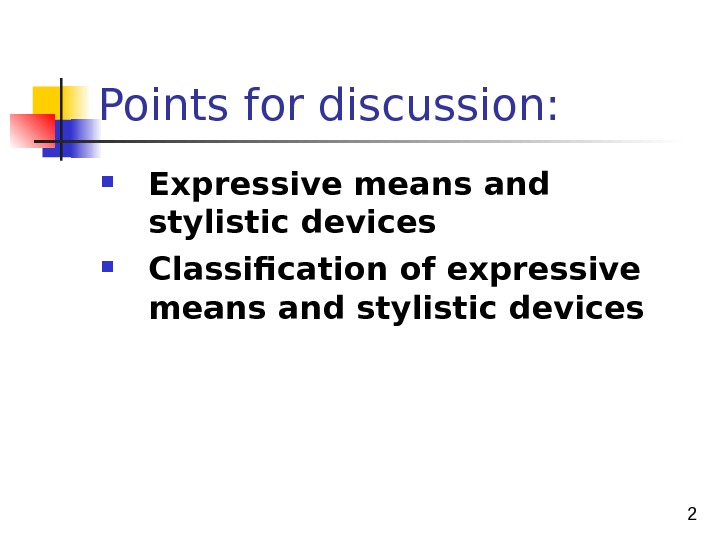

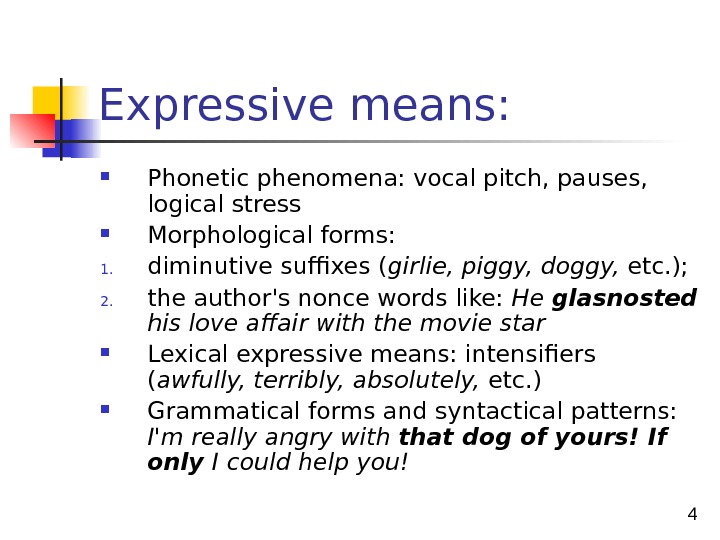

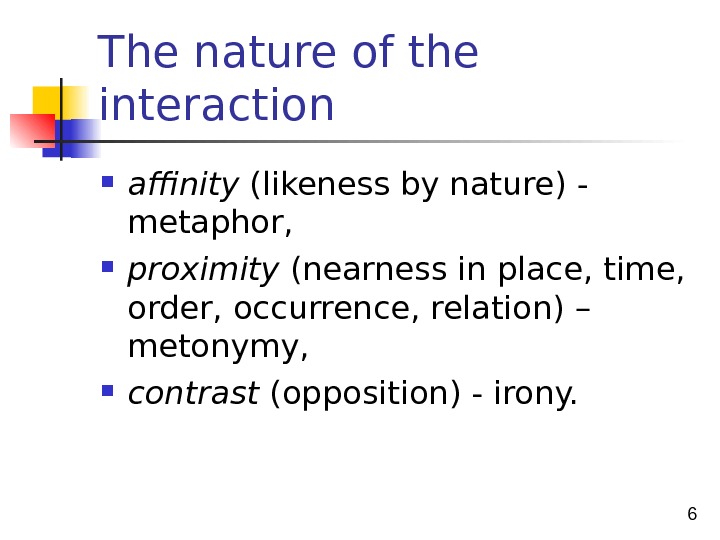

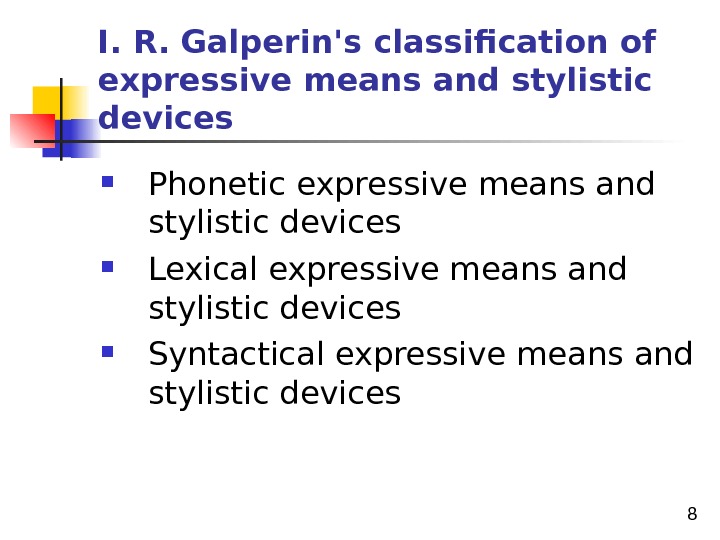
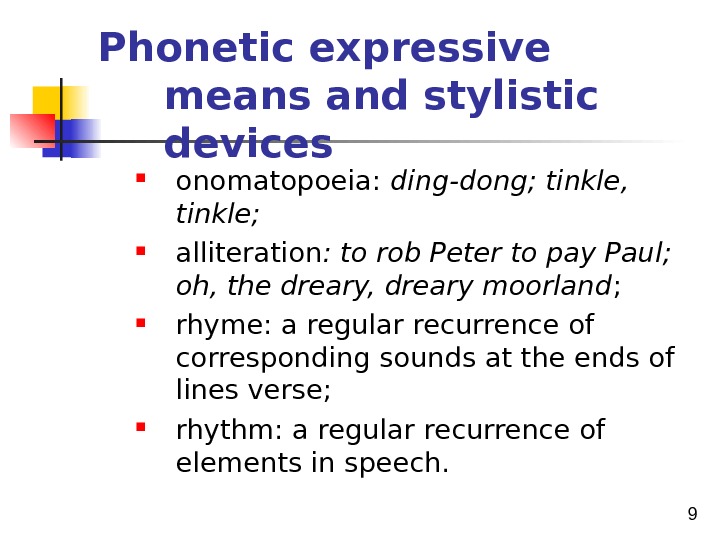
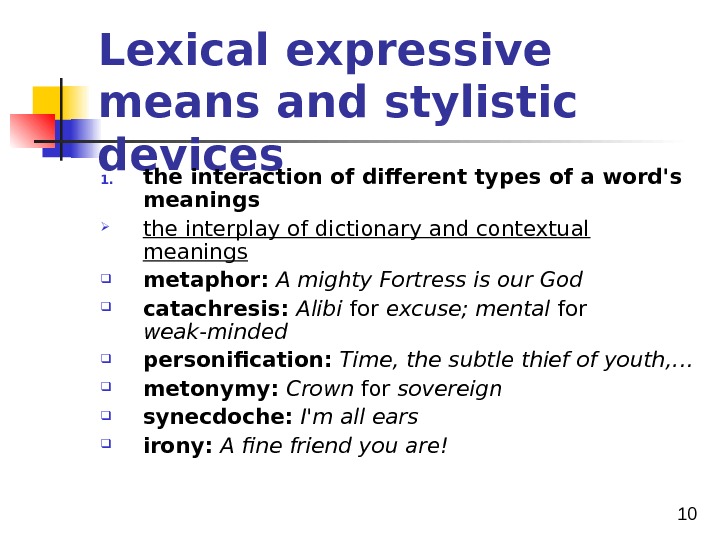

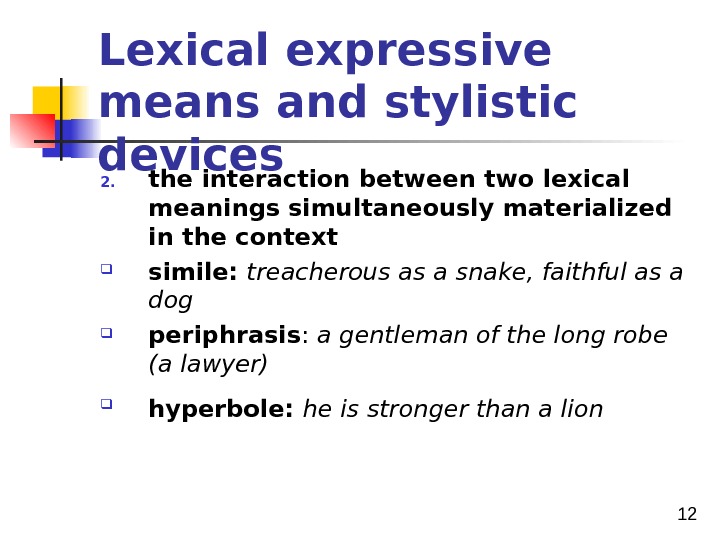



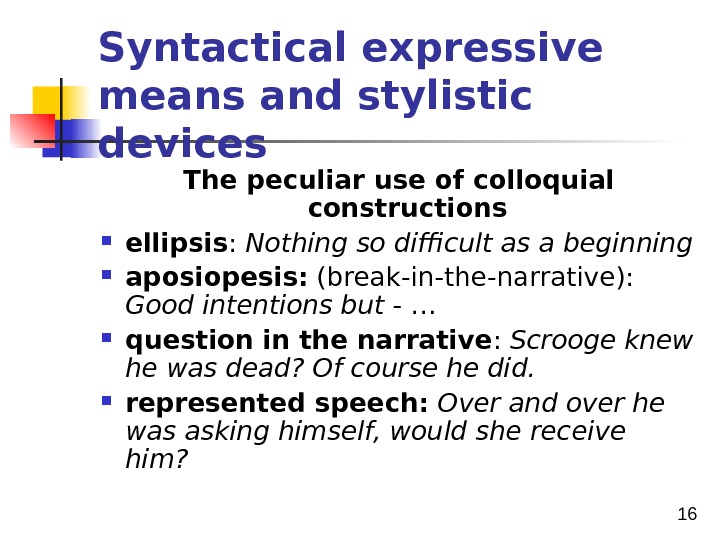
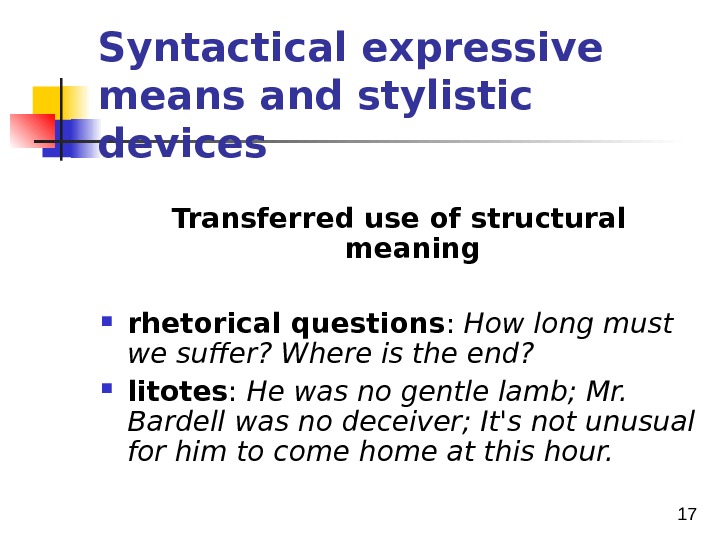
- Размер: 104.5 Кб
- Количество слайдов: 17
Описание презентации Expressive Resources of the Language 2 Points по слайдам
 Expressive Resources of the Language
Expressive Resources of the Language
 2 Points for discussion: Expressive means and stylistic devices Classification of expressive means and stylistic devices
2 Points for discussion: Expressive means and stylistic devices Classification of expressive means and stylistic devices
 3 Expressive means of a language are those linguistic forms and properties that have the potential to make the utterance emphatic or expressive
3 Expressive means of a language are those linguistic forms and properties that have the potential to make the utterance emphatic or expressive
 4 Expressive means: Phonetic phenomena: vocal pitch, pauses, logical stress Morphological forms: 1. diminutive suffixes ( girlie, piggy, doggy, etc. ); 2. the author’s nonce words like: He glasnosted his love affair with the movie star Lexical expressive means: intensifiers ( awfully, terribly, absolutely, etc. ) Grammatical forms and syntactical patterns: I’m really angry with that dog of yours! If only I could help you!
4 Expressive means: Phonetic phenomena: vocal pitch, pauses, logical stress Morphological forms: 1. diminutive suffixes ( girlie, piggy, doggy, etc. ); 2. the author’s nonce words like: He glasnosted his love affair with the movie star Lexical expressive means: intensifiers ( awfully, terribly, absolutely, etc. ) Grammatical forms and syntactical patterns: I’m really angry with that dog of yours! If only I could help you!
 5 A stylistic device is a literary model in which semantic and structural features are blended so that it represents a generalized pattern
5 A stylistic device is a literary model in which semantic and structural features are blended so that it represents a generalized pattern
 6 The nature of the interaction affinity (likeness by nature) — metaphor, proximity (nearness in place, time, order, occurrence, relation) – metonymy, contrast (opposition) — irony.
6 The nature of the interaction affinity (likeness by nature) — metaphor, proximity (nearness in place, time, order, occurrence, relation) – metonymy, contrast (opposition) — irony.
 7 The evolution of metaphor My new dress is as pink as this flower: comparison (ground for comparison—the colour of the flower) Her cheeks were as red as a tulip: simile (ground for simile— colour /beauty/ health/ freshness) She is a real flower: metaphor (ground for metaphor—frail/ fragrant/tender/ beautifu 1/ helpless. . . ) My love is a red, red rose: metaphor (ground for metaphor— passionate/beautiful/strong. . . ) Ruby lips, hair of gold, snow-white skin: trite metaphors
7 The evolution of metaphor My new dress is as pink as this flower: comparison (ground for comparison—the colour of the flower) Her cheeks were as red as a tulip: simile (ground for simile— colour /beauty/ health/ freshness) She is a real flower: metaphor (ground for metaphor—frail/ fragrant/tender/ beautifu 1/ helpless. . . ) My love is a red, red rose: metaphor (ground for metaphor— passionate/beautiful/strong. . . ) Ruby lips, hair of gold, snow-white skin: trite metaphors
 8 I. R. Galperin’s classification of expressive means and stylistic devices Phonetic expressive means and stylistic devices Lexical expressive means and stylistic devices Syntactical expressive means and stylistic devices
8 I. R. Galperin’s classification of expressive means and stylistic devices Phonetic expressive means and stylistic devices Lexical expressive means and stylistic devices Syntactical expressive means and stylistic devices
 9 Phonetic expressive means and stylistic devices onomatopoeia: ding-dong; tinkle, tinkle; alliteration : to rob Peter to pay Paul; oh, the dreary, dreary moorland ; rhyme: a regular recurrence of corresponding sounds at the ends of lines verse; rhythm: a regular recurrence of elements in speech.
9 Phonetic expressive means and stylistic devices onomatopoeia: ding-dong; tinkle, tinkle; alliteration : to rob Peter to pay Paul; oh, the dreary, dreary moorland ; rhyme: a regular recurrence of corresponding sounds at the ends of lines verse; rhythm: a regular recurrence of elements in speech.
 10 Lexical expressive means and stylistic devices 1. the interaction of different types of a word’s meanings the interplay of dictionary and contextual meanings metaphor: A mighty Fortress is our God catachresis: Alibi for excuse; mental for weak-minded personification: Time, the subtle thief of youth, … metonymy: Crown for sovereign synecdoche: I’m all ears irony: A fine friend you are!
10 Lexical expressive means and stylistic devices 1. the interaction of different types of a word’s meanings the interplay of dictionary and contextual meanings metaphor: A mighty Fortress is our God catachresis: Alibi for excuse; mental for weak-minded personification: Time, the subtle thief of youth, … metonymy: Crown for sovereign synecdoche: I’m all ears irony: A fine friend you are!
 11 Lexical expressive means and stylistic devices the interaction of primary and derivative meanings zeugma: She dropped a tear and her pocket handkerchief pun: What steps would you take if an empty tank were coming toward you? —Long ones. the opposition of logical and emotive meanings epithet: a lovely, summery evening oxymoron: peopled desert, populous solitude, proud humility the interaction of logical and nominal meanings antonomasia: a Solomon; Don Juan
11 Lexical expressive means and stylistic devices the interaction of primary and derivative meanings zeugma: She dropped a tear and her pocket handkerchief pun: What steps would you take if an empty tank were coming toward you? —Long ones. the opposition of logical and emotive meanings epithet: a lovely, summery evening oxymoron: peopled desert, populous solitude, proud humility the interaction of logical and nominal meanings antonomasia: a Solomon; Don Juan
 12 Lexical expressive means and stylistic devices 2. the interaction between two lexical meanings simultaneously materialized in the context simile: treacherous as a snake, faithful as a dog periphrasis : a gentleman of the long robe (a lawyer) hyperbole: he is stronger than a lion
12 Lexical expressive means and stylistic devices 2. the interaction between two lexical meanings simultaneously materialized in the context simile: treacherous as a snake, faithful as a dog periphrasis : a gentleman of the long robe (a lawyer) hyperbole: he is stronger than a lion
 13 Lexical expressive means and stylistic devices 3. stable word combinations in their interaction with the context clichés: crushing defeat, the whip and carrot policy proverbs and sayings: Come! he said, milk’s spilt epigrams: A thing of beauty is a joy for ever. quotations: Ecclesiastes said, ‘that all is vanity’. allusion: It’s his Achilles heel allegory: the scales of justice decomposition of set phrases : You know which side the law’s buttered.
13 Lexical expressive means and stylistic devices 3. stable word combinations in their interaction with the context clichés: crushing defeat, the whip and carrot policy proverbs and sayings: Come! he said, milk’s spilt epigrams: A thing of beauty is a joy for ever. quotations: Ecclesiastes said, ‘that all is vanity’. allusion: It’s his Achilles heel allegory: the scales of justice decomposition of set phrases : You know which side the law’s buttered.
 14 Syntactical expressive means and stylistic devices Devices built on the principle of juxtaposition anastrophe: Me he restored, him he hanged. detached constructions : She was lovely: all of her— delightful. parallel constructions : The seeds ye sow—another reaps, The robes ye weave—another wears, The arms ye forge—another bears. chiasmus: He went to the country, to the town went she. repetition : For glances beget ogles, ogles sighs, sighs wishes, wishes words, and words a letter. anaphora: No tree, no shrub, no blade of grass enumeration climax\anti-climax antithesis: Youth is lovely, age is lonely; Youth is fiery, age is frost
14 Syntactical expressive means and stylistic devices Devices built on the principle of juxtaposition anastrophe: Me he restored, him he hanged. detached constructions : She was lovely: all of her— delightful. parallel constructions : The seeds ye sow—another reaps, The robes ye weave—another wears, The arms ye forge—another bears. chiasmus: He went to the country, to the town went she. repetition : For glances beget ogles, ogles sighs, sighs wishes, wishes words, and words a letter. anaphora: No tree, no shrub, no blade of grass enumeration climax\anti-climax antithesis: Youth is lovely, age is lonely; Youth is fiery, age is frost
 15 Syntactical expressive means and stylistic devices Devices based on the type of connection asyndeton : He provided the poor with jobs, with opportunity, with self-respect polysyndeton: He thought, and thought gap-sentence link : It was an afternoon to dream. And she took out Jon’s letters
15 Syntactical expressive means and stylistic devices Devices based on the type of connection asyndeton : He provided the poor with jobs, with opportunity, with self-respect polysyndeton: He thought, and thought gap-sentence link : It was an afternoon to dream. And she took out Jon’s letters
 16 Syntactical expressive means and stylistic devices The peculiar use of colloquial constructions ellipsis : Nothing so difficult as a beginning aposiopesis: (break-in-the-narrative): Good intentions but — … question in the narrative : Scrooge knew he was dead? Of course he did. represented speech: Over and over he was asking himself, would she receive him?
16 Syntactical expressive means and stylistic devices The peculiar use of colloquial constructions ellipsis : Nothing so difficult as a beginning aposiopesis: (break-in-the-narrative): Good intentions but — … question in the narrative : Scrooge knew he was dead? Of course he did. represented speech: Over and over he was asking himself, would she receive him?
 17 Syntactical expressive means and stylistic devices Transferred use of structural meaning rhetorical questions : How long must we suffer? Where is the end? litotes : He was no gentle lamb; Mr. Bardell was no deceiver; It’s not unusual for him to come home at this hour.
17 Syntactical expressive means and stylistic devices Transferred use of structural meaning rhetorical questions : How long must we suffer? Where is the end? litotes : He was no gentle lamb; Mr. Bardell was no deceiver; It’s not unusual for him to come home at this hour.

